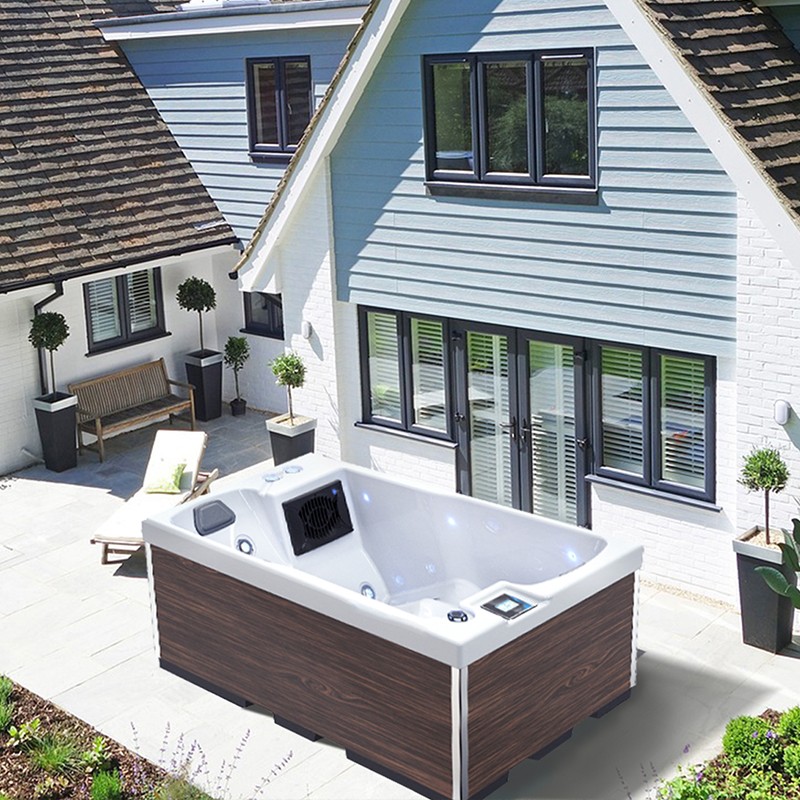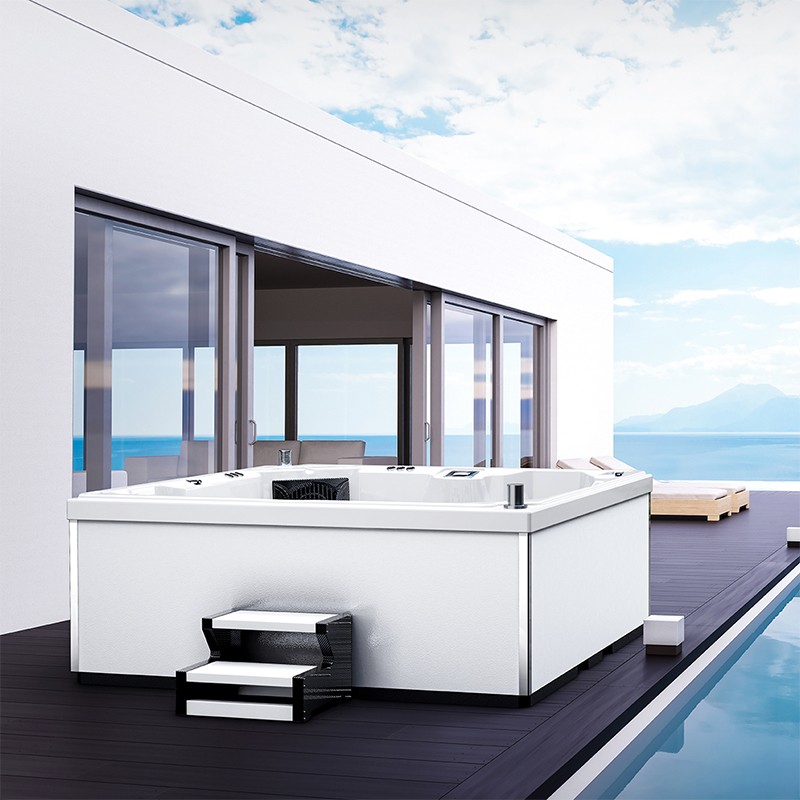
Will acrylic spa hot tubs turn yellow?
2025-11-06 15:30Acrylic spa hot tubs are popular for their aesthetics, lightweight design, and excellent heat retention. However, some users have noticed a yellowing of the surface over time. This not only affects the tub's aesthetics but also raises concerns about its lifespan, material quality, and cleaning and maintenance.
So, do acrylic spa hot tubs really turn yellow? If so, what causes it? Is this yellowing preventable or reversible? This article will delve into this issue through a systematic and professional analysis of the inherent properties of acrylic, taking into account chemical stability, operating environment, water quality, cleaning methods, and maintenance precautions.

Basic Structure and Material Characteristics of Acrylic Spa Hot Tubs
1. Overview of Acrylic Materials
Acrylic, or polymethyl methacrylate (PMMA), is a thermoplastic polymer widely used in hot tub surfaces due to its excellent transparency and surface finish. Acrylic spa hot tubs typically consist of three layers:
· Surface layer: Pure acrylic sheet, offering high gloss, water resistance, and stain resistance;
· Middle layer: Glass fiber-reinforced resin for increased structural strength;
· Bottom layer: Polyurethane foam layer or steel frame support for enhanced overall stability and thermal insulation.
2. Material Advantages
Acrylic spa hot tubs are popular due to their following advantages:
· Smooth, easy to clean, and resistant to stains;
· High thermal insulation, ensuring hot water retains its heat for extended periods;
· Lightweight and easy to install;
· Available in a variety of colors for a pleasant visual experience;
· Excellent water and humidity resistance.
However, despite its many advantages, acrylic is still a high-molecular-weight polymer, and its surface stability is limited under certain chemical or environmental conditions. This provides the theoretical basis for its yellowing.

Analysis of the Possibility of Acrylic Spa Hot Tubs Turning Yellow
1. Material Aging
Acrylic is a synthetic resin material. Prolonged exposure to high temperature, high humidity, water vapor, and even ultraviolet light can cause molecular chain degradation, resulting in yellowing, darkening, and even fine cracks on the surface.
Causes and Mechanisms:
· Thermal decomposition leads to chain segment breakage;
· Ultraviolet radiation damages the polymer structure;
· Water vapor forms oxides or microbial residues.
Poor ventilation and prolonged high temperatures significantly increase the likelihood of surface aging and yellowing of the acrylic spa hot tub.
2. Improper Cleaning
Many users use strong alkaline cleaners (such as bleach and sodium hydroxide) or abrasive cleaners (such as toilet powder and steel wool). These substances react with acrylic, damaging the surface structure and causing:
· Reduced surface gloss;
· Increased stain adhesion;
· Pigmentation exacerbates surface yellowing.
3. Water Quality
Water quality directly affects the surface condition of the bathtub. Hard water contains large amounts of calcium and magnesium ions, which accumulate over time to form scale. Rust, organic matter, and chlorine residue in the water can also cause chemical reactions, resulting in yellowish deposits.
These deposition reactions are particularly accelerated in hot water:
· Iron ions oxidize to form a yellow rust film;
· Organic matter deposits on the surface, forming a film that attracts bacteria;
· Chlorine reacts with acrylic, forming a microscopic pigment deposit.
4. Chemical Disinfectant Residue
Some users habitually add disinfectants (such as bleach, chlorine tablets, and chlorine powder) to their acrylic spa hot tubs. Prolonged contact between these chlorine-containing chemicals and acrylic can cause the following problems:
· Changes in the pH of the acrylic surface;
· Localized oxidative discoloration;
· Residual components convert to yellow or brownish-yellow substances upon heating.
5. Air Pollution and Daily Environmental Impacts
If the air quality in the space where the acrylic spa hot tub is located is poor, such as due to the presence of:
· Tobacco smoke;
· Oil fume pollution;
· Long-term dust accumulation, etc.
These organic particles bind to the bathtub surface and are easily deposited and penetrated by high-temperature steam, causing discoloration.

Symptoms of Yellowing in Acrylic Spa Hot Tubs
Depending on the degree and extent of the discoloration, yellowing of acrylic spa hot tubs can be categorized as follows:
Types | Characteristics |
| Localized yellowing | Mostly appears at the bottom of the bathtub, near the waterline, or around the drain outlet, with noticeable color variation |
| Uniform yellowing | The overall surface color changes from white to light yellow, lacking luster |
| Potty-like deposits | Spots or streaks of yellowish-brown stains are often caused by rust or scale |
| Yellowing of the transparent layer | Some translucent acrylic bathtubs experience a uniform yellowing that spreads from the inside out |
Once these phenomena occur, if not addressed promptly, they can permanently damage the acrylic surface structure, seriously affecting its lifespan and aesthetics.
How to Prevent Yellowing in Acrylic Spa Hot Tubs?
1. Properly Control Water Temperature
Although acrylic spa hot tubs have excellent thermal insulation properties, they should not be maintained at extremely high water temperatures (e.g., above 45°C) for extended periods. It is recommended that the water temperature be maintained between 36°C and 42°C to slow thermal decomposition.
2. Use Mild Cleaners
Avoid using cleaners containing chlorine, strong acids, or strong bases. Recommended Uses:
· Neutral foaming detergent;
· Special acrylic bathtub cleaning spray;
· Wipe with a soft cloth or sponge, avoiding scratching the surface.
The recommended cleaning frequency is 1-2 times per week to prevent dirt accumulation and pigmentation.
3. Regularly soften your water source
If your area has hard water, install a water softener or filter to reduce the concentration of calcium and magnesium ions, preventing scale from accumulating and yellowing under high temperatures.
4. Avoid direct sunlight
If your acrylic spa hot tub is installed near a window or outdoors, be sure to take UV protection measures, such as curtains or sunshades, to prevent UV rays from breaking down the polymer structure and causing yellowing.
5. Avoid mixing chemicals
During cleaning or disinfection, never mix chemicals with different ingredients, such as bleach + vinegar or chlorine tablets + hydrogen peroxide, to prevent adverse reactions that can damage the tub and cause yellowing.

What should I do if my acrylic spa hot tub turns yellow?
If your acrylic spa hot tub has already developed mild yellowing, you can try the following restoration methods:
1. Using an Oxidation-Reducing Cleaner
Oxidation-reducing cleaners are commercially available for acrylic surface discoloration, breaking down pigment deposits and restoring the surface's luster. When using, strictly follow the dilution ratio specified in the instructions and avoid overuse.
2. White Vinegar and Baking Soda (Minor Yellowing)
For yellowing caused by limescale, you can:
· Add white vinegar and baking soda to warm water;
· Wipe with a soft cloth or sponge;
· Let sit for 15 minutes, then rinse.
This method is suitable for light household cleaning but is not suitable for severe chemical discoloration.
3. Polishing Acrylic Repair
If the yellowing is severely detrimental to the appearance, hire a professional for surface polishing. This polishing removes the shallow oxide layer and restores the original luster. However, caution should be exercised to avoid damaging the protective layer.
Will acrylic spa hot tubs yellow?
The answer is: Acrylic spa hot tubs can indeed yellow under adverse operating conditions, improper cleaning and maintenance, or due to material aging.
Causes include material aging, mineral deposits in the water, UV exposure, and improper cleaning. However, acrylic, as a relatively stable thermoplastic material, retains its color well under normal use.
The key lies in proper care and proper use of the acrylic spa hot tub:
· Proper temperature control;
· Proper cleaning;
· Sun protection and chlorine avoidance;
· Regular maintenance.
If these points are followed, the lifespan of the acrylic spa hot tub can be significantly extended, maintaining its pristine, bright white appearance.
Are LOVIA SPA products suitable for commercial projects?
Absolutely. LOVIA SPA supplies high-quality outdoor spas, swim spas, and hot tubs for hotels, wellness centers, resorts, and spas. Our products are customizable in size, design, and features to meet commercial requirements.
LOVIA SPA ensures professional guidance, timely delivery, and after-sales support for commercial buyers, making us a reliable supplier for businesses needing high-quality spa products.
